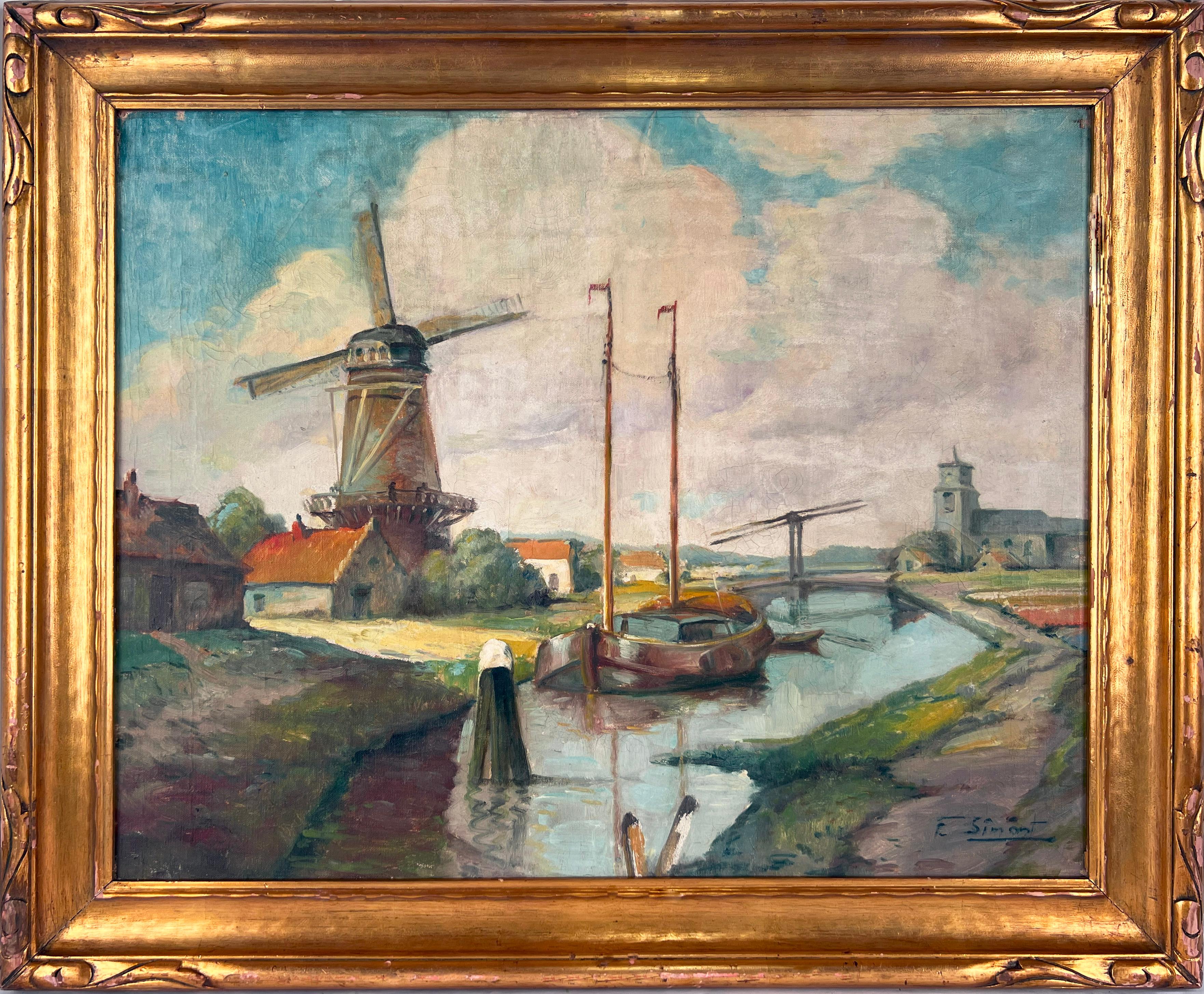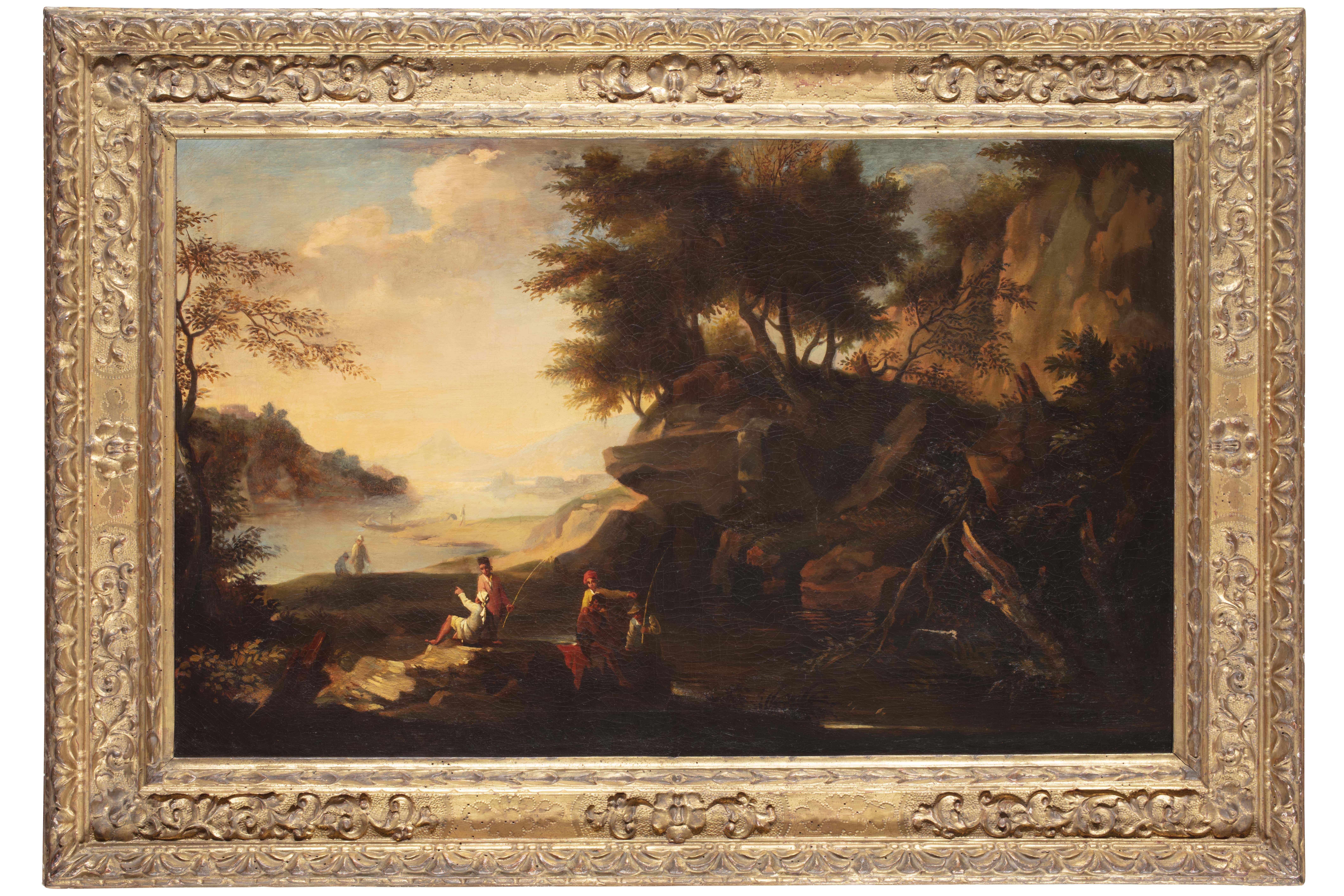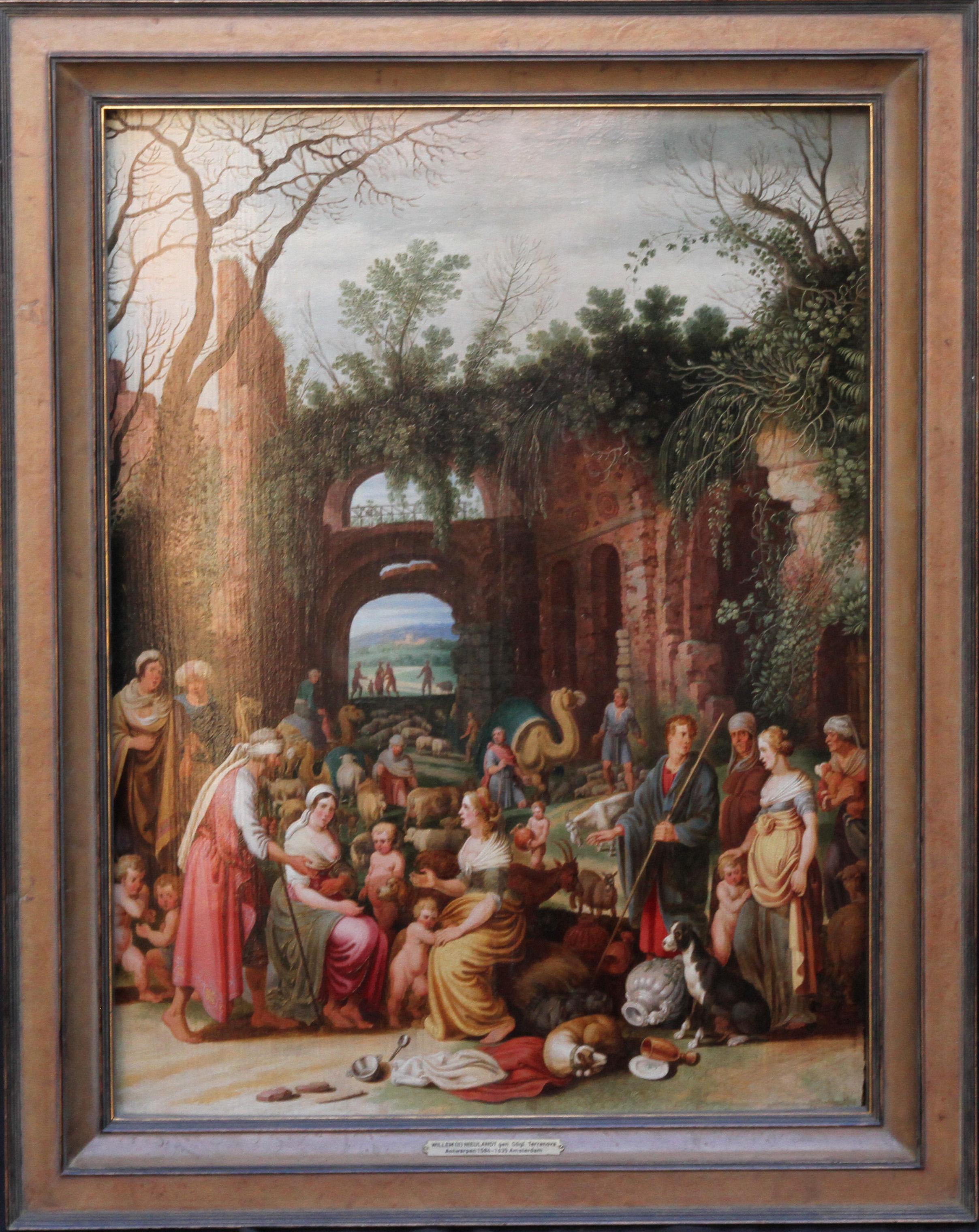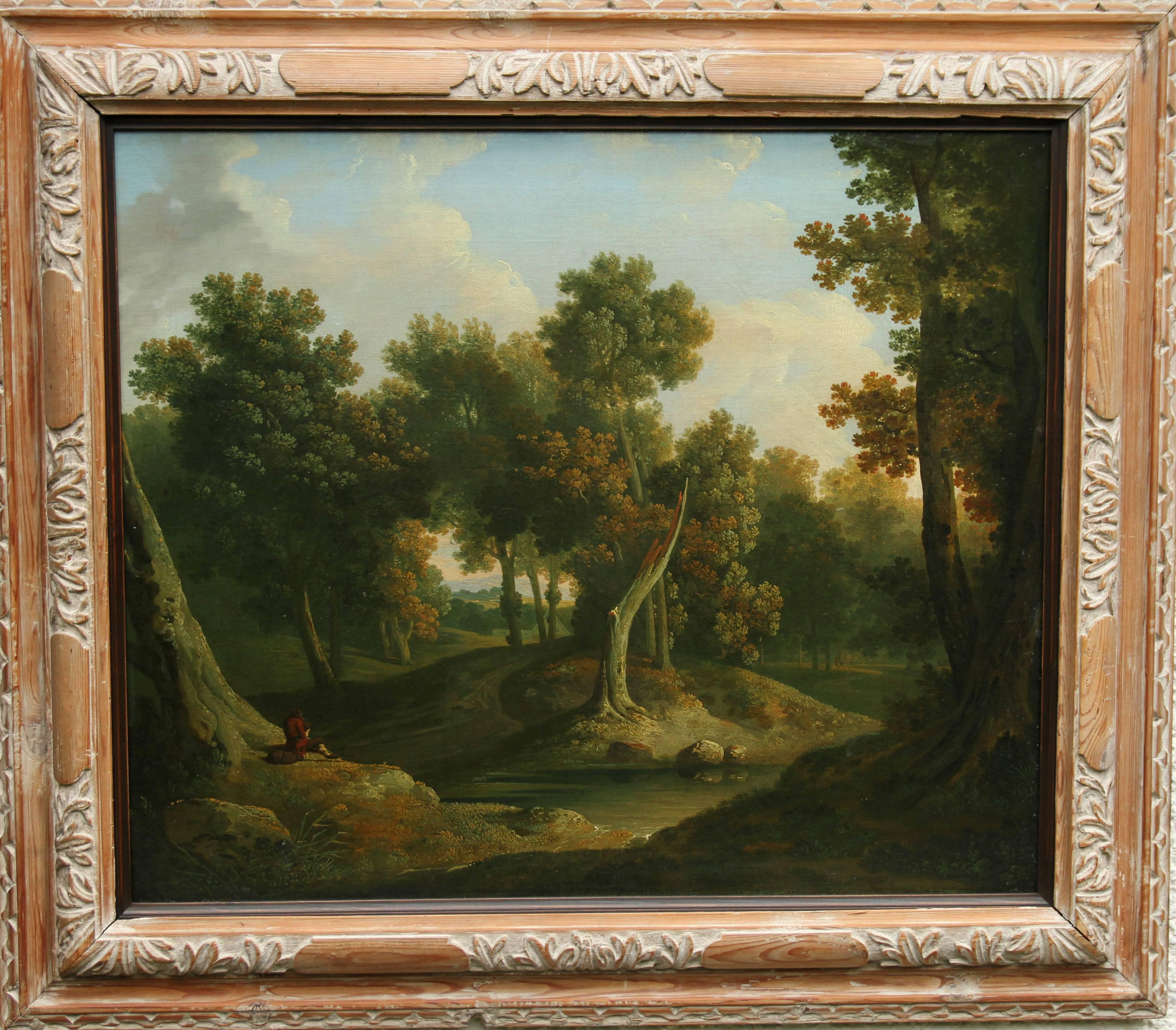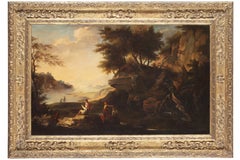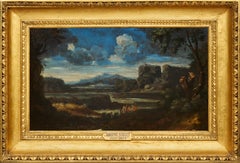Items Similar to Van Den Bossche Alexander The Great Paint Oil on canvas 17/18th Century Flemish
Want more images or videos?
Request additional images or videos from the seller
1 of 23
Van Den Bossche Alexander The Great Paint Oil on canvas 17/18th Century Flemish1695-1721
1695-1721
About the Item
Balthasar Van Den Bossche (Antwerp, 1681 - 1715)
Alexander the Great and Campaspe in the studio of the painter Apelles
The canvas was exhibited in Perugia (Museo di Palazzo della Penna) at the exhibition "RENAISSANCE IN THE BOTTEGA: PERUGINO AMONG THE GREATS OF HISTORY" (29 October 2023 - 28 January 2024) - see photo details -.
Oil painting on canvas
120 x 162 cm. - In gilded frame 135 x 176 cm.
This fascinating painting, a real gem for any connoisseur and collector of old paintings, depicting Alexander the Great in the studio of the painter Apelles to view the portrait of his favourite concubine Campaspe, is a quality work by the Flemish artist Balthasar Van Den Bossche (Antwerp 1681 - 1715).
Born in Antwerp, he trained in the workshop of Gerard Thomas and was awarded the title of master in the Antwerp Guild as early as 1697. This was followed by a move to Paris, documented until 1700, where he founded his own studio, alternating his work as a painter with that of an art dealer. His combination of the elegance of the French style with Flemish characters brought him enormous success among Parisian collectors.
The collector's success of his creations was remarkable, obtaining the patronage of important personalities such as the Duke of Marlborough, his fervent patron. He finished his career in his home town, with a flourishing workshop, specialising in interior paintings of studios and picture galleries.
Our beautiful canvas, presumably executed at the turn of the century, is a fine example of his production, rich in detail and of great charm.
It depicts an episode recounted by Pliny the Elder in his work Naturalis Historia (Book xxxv, 85-87), written in 77 A.D., in which it is narrated that the illustrious painter Apelles, thanks to his enormous artistic talents, became the favourite of Alexander the Great, who called him to paint the portrait of Campaspe, the favourite among his concubines;
During the execution of the work, the painter fell madly in love with the young woman, who was therefore given to him by the leader as a form of thanks for his services. The anecdote of Apelles and Campaspe is often quoted and illustrated because it shows the high esteem of a ruler for his court painter, whose artistic ability is highly appreciated and who, therefore, occupies an important position in society.
As early as the 16th century, this subject was habitually included among the 'exempla virtutis' within celebratory decorations, as the act of handing over the young Campaspe to Apelles was considered an example of the magnanimity of Alexander the Great and thus reflected the moral qualities of the patron, who, thus compared to the valiant leader, implicitly acquired his gifts;
Let us now enter into the details of the composition, which sees the painter, seated in front of his easel, observing the beauty of the young woman posing and then portraying her features, and at his side Alexander in bright red Renaissance clothing, who looks critically at the painting to be completed.
The scene is animated by a small Cupid, hidden behind the easel, who is about to shoot his love arrow towards the painter.
In the central part the painter has inserted two animals, particular for their allegorical meanings and recalling the two male protagonists of the canvas: a monkey, tied by an iron ball, embodying carnal instincts and lust, with a dog at his side, alluding instead to loyalty and deep friendship.
Framing the scene, one cannot but be struck by the setting of the artist's large workshop, rich in details such as the classical sculptures, the numerous paintings that are already completed and the still life with precious objects near the young woman lying down.
The peculiarity of this type of work, typical of the old Flemish tradition, is precisely the precision and richness of detail with which the painter enriched his settings, destined for wealthy patrons. In such compositions, the taste for depicting opulent environments emerges, alluding to the social superiority but above all to the culture and passion for art of the wealthy patrons.
The painting is in an excellent state of preservation and is accompanied by an antique gilded frame.
The painting is sold with a certificate of authenticity and a descriptive iconographic card.
We take care of and organise the transport of the purchased works, both for Italy and abroad, through professional and insured carriers.
Contact us for any information, we will be happy to answer you.
- Attributed to:Balthasar Van Den Bossche (Antwerp, 1681 - 1715) (1681 - 1715)
- Creation Year:1695-1721
- Dimensions:Height: 53.15 in (135 cm)Width: 69.3 in (176 cm)
- Medium:
- Movement & Style:
- Period:
- Condition:
- Gallery Location:Riva del Garda, IT
- Reference Number:1stDibs: LU988113586192
About the Seller
4.9
Platinum Seller
Premium sellers with a 4.7+ rating and 24-hour response times
Established in 2017
1stDibs seller since 2018
238 sales on 1stDibs
Typical response time: <1 hour
- ShippingRetrieving quote...Shipping from: Riva del Garda, Italy
- Return Policy
Authenticity Guarantee
In the unlikely event there’s an issue with an item’s authenticity, contact us within 1 year for a full refund. DetailsMoney-Back Guarantee
If your item is not as described, is damaged in transit, or does not arrive, contact us within 7 days for a full refund. Details24-Hour Cancellation
You have a 24-hour grace period in which to reconsider your purchase, with no questions asked.Vetted Professional Sellers
Our world-class sellers must adhere to strict standards for service and quality, maintaining the integrity of our listings.Price-Match Guarantee
If you find that a seller listed the same item for a lower price elsewhere, we’ll match it.Trusted Global Delivery
Our best-in-class carrier network provides specialized shipping options worldwide, including custom delivery.More From This Seller
View AllRotterdam Port See Italian Paint Oil on canvas 18th Century Old master Flemish
Located in Riva del Garda, IT
Pair of views of Rotterdam: The Stock Exchange building / View of the canal with the old port
Eighteenth-century Vedutist painter
oils on canvas
47 x 66 cm. - with frame 56 x 75 cm.
This pleasant pair of paintings depict two glimpses of the city of Rotterdam, investigated here as vivid documentaries of the habits and customs from the public life of the wealthy Dutch port city, as well as one of the founders of the Dutch East India Company, is an excellent example of 18th century Vedutism
We see, in particular, in the first work the monumental Palazzo della Borsa (defined as Il Beurs), designed by the architect Adriaen van der Werff in Westnieuwland, initially a place destined for legislation on trade, where merchant-bankers met periodically to exchange securities credit and enter into sales; it is located on the bank of the Nordblaak River and shot with the Gaapers Bridge in the foreground.
The second work immortalizes the docking of the ancient port of Rotterdam, with the foreground view of the two city gates (the Wester Old Hoofdpoort on the left and the Ooster Oude Hoofdpoort on the right); in the background on the left the St. Laurenskerk (Church of San Lorenzo), also called the Great Church of Rotterdam, is the only medieval structure, while on the right the English Church.
Very well executed, characterized by a marked brightness and a chromatic range with bright colors and highlighted by the contrast between lights and shadows, our canvases are a very interesting testimony of eighteenth-century Rotterdam, portraying two of the views that have historically influenced a lot on economic history of the city.
We can attribute the authorship to an author of the full eighteenth century, inspired by the pictorial style of the Italian landscape painters and whose iconography was presumably drawn from the numerous prints with perspective views made through the optical cameras.
In particular, these views of Rotterdam draw their iconographic origin from a collection of perspective prints of the most influential European cities, made by the engraver Johann Balthasar Probst (1732-1801), characterized by a remarkable refinement in the line, at the service of a sense of perspective of undoubted value, and above all characterized by a strong Nordic taste.
Descendant of a large family of Augsburg engravers, Probst contributed to making his workshop an important European publishing center between the 17th and 18th centuries, among the major German print publishers in the first half of the 18th century.
Despite his travels, including in Italy, between Venice, Rome and Naples, not all the cities he portrayed were drawn from life but taken from earlier prints and drawings and filtered through northern European clichés.
Many of these engravings have been lost and are now difficult to find on the antiques market.
Category
18th Century Old Masters Paintings
Materials
Oil
$10,647 Sale Price
20% Off
Landscape Zuccarelli Paint Oil on canvas Old master 18th Century Italian View
By Francesco Zuccarelli (Pitigliano 1702 - Florence 1788)
Located in Riva del Garda, IT
Francesco Zuccarelli (Pitigliano 1702 - Florence 1788), circle of
Landscape with river and resting shepherds
First half of the 18th century
oil painting on canvas
cm. 60 x 93, within a carved and gilded wooden frame cm. 75 x 108
This delightful landscape view animated by a family of shepherds who rest from their daily duties should be compared to the hand of Francesco Zuccarelli (Pitigliano 1702 - Florence 1788);
In the landscapes painted by Zuccarelli the world is crystallized, frozen in a moment of idyllic quiet,
where the 'Arcadian' sense of the landscape is rendered with that pictorial vivacity, chromatic lightness and compositional grace that we find in its entirety in his painting.
By way of comparison we can compare our canvas to other compositions, including:
- Landscape with river and resting shepherds, Accademia Carrara, Bergamo
- Landscape with bridge and horseman, Accademia Carrara, Bergamo
- Landscape with river, village, fisherman and shepherdesses' (Christie's, London May 1960,
- Landscape with figures, Accademia Carrara,
- Landscape with knight and figures, Accademia Carrara
Tuscan by origin, Francesco Zuccarelli trained first in Florence with the landscape architect Paolo Anesi...
Category
18th Century Old Masters Paintings
Materials
Oil
$8,409 Sale Price
20% Off
Carnival Rome Navona square Cerquozzi 17th Century Paint Oil on canvas Italy
Located in Riva del Garda, IT
Carnival scene in 17th-century Rome (in Piazza Navona)
Michelangelo Cerquozzi (Rome 1602 – Rome 1660) workshop
Roman school of bamboccianti (mid-17th century)
Oil on canvas
74 x 96...
Category
17th Century Old Masters Paintings
Materials
Oil
$10,405 Sale Price
20% Off
The Resting Of Diana, Guillaume Courtois Known As 'il Borgognone' (1626 - 1679)
Located in Riva del Garda, IT
Guillaume Courtois known as 'il Borgognone' (Saint Hippolyte 1626 - Rome 1679)
The Resting of Diana
Oil on canvas (97 x 70 cm. - Framed cm. 121 x 95)
The proposed painting, of exqui...
Category
17th Century Old Masters Paintings
Materials
Oil
$7,138 Sale Price
20% Off
Van Bloemen Landscape Rome Paint 17/18th Century Oil on canvas Old master Italy
Located in Riva del Garda, IT
Antichità Castelbarco SRLS is proud to present:
Painting depicting "View of Rome with countryside scene with ancient ruins, with the Palatine from via dei Cerchi", work of high qual...
Category
17th Century Old Masters Paintings
Materials
Oil
$8,329 Sale Price
20% Off
Coastal Landscape See Paint Lacroix de Marseille Oil on canvas 18th Century Art
Located in Riva del Garda, IT
Coastal view at sunset with fishermen and boats
Atelier of Charles François Grenier De Lacroix, called de Marseille (Marseille 1700 - Berlin 1782)
Oil on canvas
50 x 62 cm. - in fra...
Category
18th Century Old Masters Paintings
Materials
Oil
$7,122 Sale Price
20% Off
You May Also Like
Mid Century Dutch Windmill Original Oil in Dutch Impressionist Style
Located in Soquel, CA
Mid Century Dutch Windmill Original Oil in Dutch Impressionist Style
Colorful French impressionist style oil painting by F. Simont (Dutch 19th/20t...
Category
1950s Old Masters Landscape Paintings
Materials
Linen, Oil, Stretcher Bars
17th Century by Jacob de Heusch Pair of Landscapes Oil on Canvas
Located in Milano, Lombardia
Jacob De Heusch (Utrecht, Netherlands, 1657 – Amsterdam, Netherlands, 1701)
Title: Pair of Landscapes
Medium: Oil on canvas
Dimensions: without frame 50 x 8...
Category
17th Century Old Masters Landscape Paintings
Materials
Canvas, Oil
Italian Landscape with Jack Players, a painting by Gaspard Dughet (1615 - 1675)
By Gaspard Dughet
Located in PARIS, FR
Here Gaspard Dughet offers us an idyllic vision of the Roman countryside. The stages follow one another in a perfectly structured composition, revealing here a lake, there travellers walking along, gradually leading our eye to the blue horizon. But behind its classical composition, this landscape is particularly interesting because of three anthropomorphic details that the artist has hidden, opening the way to a radically different interpretation...
1. Gaspard Dughet, a landscape artist in the light of Poussin
Gaspard Dughet was born on June 4th, 1615 in Rome where his father, of French origin, was a pastry cook. He was probably named Gaspard in honour of his godfather Baron Gaspard de Morant, who was, or may have been, his father's employer. His older sister Jeanne married the painter Nicolas Poussin (1594 - 1655) on September 1st, 1630. The young Gaspard was apprenticed with his brother-in-law at the beginning of 1631, which led his entourage to name him Gaspard Poussin. The first preserved works of the painter date from the years 1633-1634 and were painted in Poussin’s studio.
Around 1635, Gaspard Dughet became emancipated and began to frequent the Bamboccianti circle. In 1636, he became friends with the painter Jean Miel (1599 - 1656), but also with Pier Francesco Mola (1612 - 1666) and Pietro da Cortona (1596 - 1669).
This was also the time of his first trips throughout Italy. The painter, although of French origin, appears never to have visited France. In 1646 he settled permanently in Rome. A recognized painter with a solid book of orders, he remained faithful to landscape painting throughout his life, alternating between cabinet paintings and large decorative commissions, using both oil and fresco.
Nailed to his bed by rheumatic fever at the age of 58, he died on May 25, 1675.
2. Discovering an idealized landscape
Beyond a relatively dark foreground that takes us into the landscape, we discover a vast bluish horizon: a plateau surrounded by deep ravines advances to the right, overhanging an expanse of water that sparkles below. A road winds through a mountainous mass as if leading us to the fortress that crowns it; another town appears in the distance at the foot of three conical mountains.
The composition is rigorous, mineral, and structured by geometric volumes. The various stages in the landscape lead one to the next attracting the eye towards the horizon located in the middle of the canvas. The general impression is that of a welcoming and serene nature.
In many places the paint layer has shrunk, or become transparent, revealing the dark red preparation with which the canvas was covered and accentuating the contrasts.
Human presence is limited to three jack players, leaning against a mound in the foreground. Their long garments, which may evoke Roman togas, contribute to the timelessness of the scene.
Close examination of the canvas reveals two other travellers on the path winding between the rocks. Made tiny by the distance, their introduction in the middle register, typical of Dughet's art, lengthens the perspective.
While it is difficult to date the work of a painter who devoted his entire life to the representation of landscapes, it is certain that this painting is a work from his later years. The trees that occupied the foreground of his youthful compositions have been relegated to the sides, a stretch of water separates us from the arid mountains counterbalanced by two trees represented on the opposite bank. The introduction of this stretch of water in the middle of the landscape betrays the influence of the Bolognese and in particular of the Dominiquin (1581 - 1641)
A number of similarities with a drawing in the British Museum might suggest a date around 1656-1657, since, according to Marie-Nicole Boisclair , it has been compared with the Prado's Landscape with the Repentant Magdalene, painted at that period.
3. Three amazing anthropomorphic details
While some late Renaissance landscapes offer a radical double reading, allowing one to see both a face or a human body behind the representation of a landscape, it seems interesting to us to hypothesize that Gaspard Dughet had fun here by slipping in a few details that, taken in isolation, evoke human or animal figures.
We will give three examples, looking closely at a cloud, the trunk of a broken tree and the top of a cliff.
The main cloud could thus evoke a Christ-like face or that of an antique god...
Category
1650s Old Masters Landscape Paintings
Materials
Oil
Laban Demanding the Return of the Teraphim from Rachel - Dutch Old Master art
By Willem van Nieulandt II
Located in London, GB
This very busy oil on panel is a Dutch Old Master painting dating to around 1620 by artist and poet Willem van Nieulandt. It is an incredibly detailed and colourful scene composed of...
Category
17th Century Old Masters Figurative Paintings
Materials
Oil
Villagers in a Landscape - Flemish 17thC art figurative landscape oil painting
Located in London, GB
This fantastic Flemish 17th century Old Master oil painting is by Thomas Van Apshoven. It was painted circa 1650 and depicts a village with figures outside a tavern, eating, drinking and dancing. Beyond are more dwellings, villagers and animals, all under a blue summer's sky. The detail, brushwork and vibrant colouring are superb. This is an excellent example of Apshoven's work and a typical subject he loved to paint.
Provenance. Leominster estate.
Wax stamp verso.
Condition. Oil on panel, 22 inches by 17 inches and in good condition.
Frame. Housed In beautiful gilt frame, 30 inches by 25 inches and in good condition.
Thomas van Apshoven (1622– 1664) was a Flemish painter known for his landscapes with peasant scenes and genre scenes in interiors. His genre scenes depict village festivals, the interiors of taverns, village scenes or landscapes with peasants engaged in various activities, singeries, guardroom scenes and laboratories of alchemists. Some still lifes have also been attributed to him. His themes and style are close to that of David Teniers the Younger. He was born on 30 November 1622 in Antwerp as the eldest son of Ferdinand van Apshoven the Elder and Leonora Wijns. His father was a painter who had studied with Adam van Noort and had become a master of the Antwerp Guild of Saint Luke in 1596. No paintings by his father are known. His younger brother Ferdinand van Apshoven the Younger became also a successful painter. Thomas studied under his father. Some sources state that he became a pupil of the prominent genre painter David Teniers the Younger. It is more likely, however, that he was an imitator of Teniers. He was registered as a 'wijnmeester' [son of a master] in the Guild of St. Luke of Antwerp in the guild year 1645–1646. He married Barbara Janssens on 22 March 1645. The couple had four children. The godfathers of the children included the painters Victor Wolfvoet...
Category
1650s Old Masters Figurative Paintings
Materials
Oil
Old Master Wooded Landscape - Irish 1830 art woodland oil painting
By James Arthur O'Connor
Located in London, GB
A delightful large oil on canvas of a wooded landscape which dates to circa 1830 and is attributed to Irish artist James Arthur O’Connor. A superb painting and an excellent example o...
Category
18th Century Old Masters Landscape Paintings
Materials
Oil
$43,453 Sale Price
20% Off
Recently Viewed
View AllMore Ways To Browse
The Den
Antwerp Art
Oil Paintings 17 Century
Flemish Paintings
Alexander The Great
Old Masters Renaissance Paintings
Interior Old Book
Ruler Art
Thomas Downing Artist
Renaissance 18th Century Painting
Friendship Book
Alexander Young
Alexander Antiques
Small Gilded Framed Art
Flemish Portrait Painting
Old Antique Picture Frames
Flemish 18th Century
Italian Paintings 16th Century
